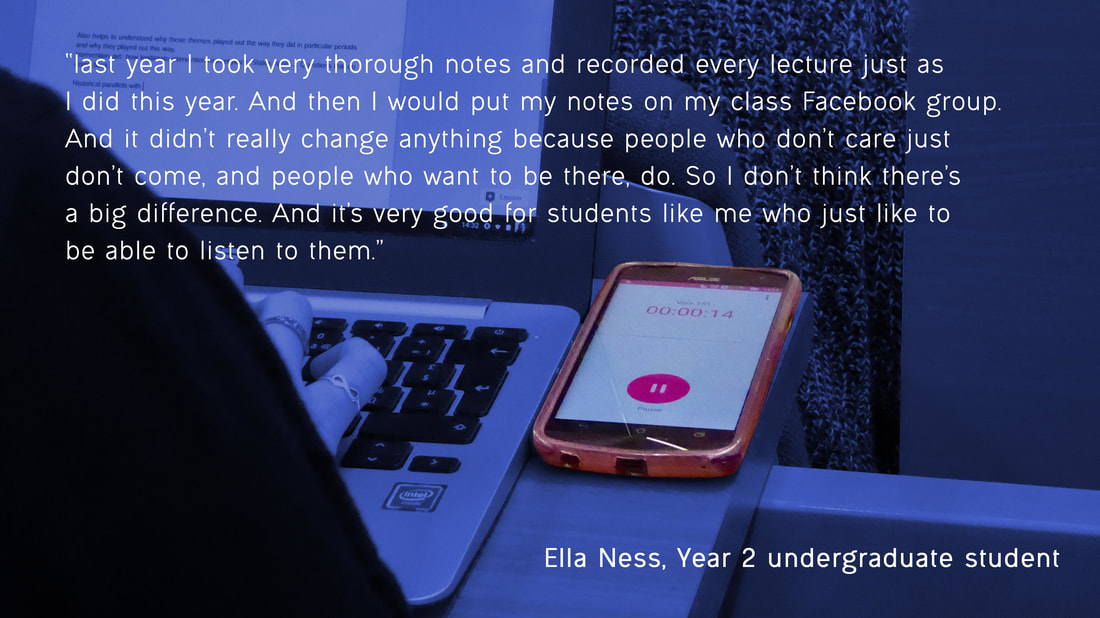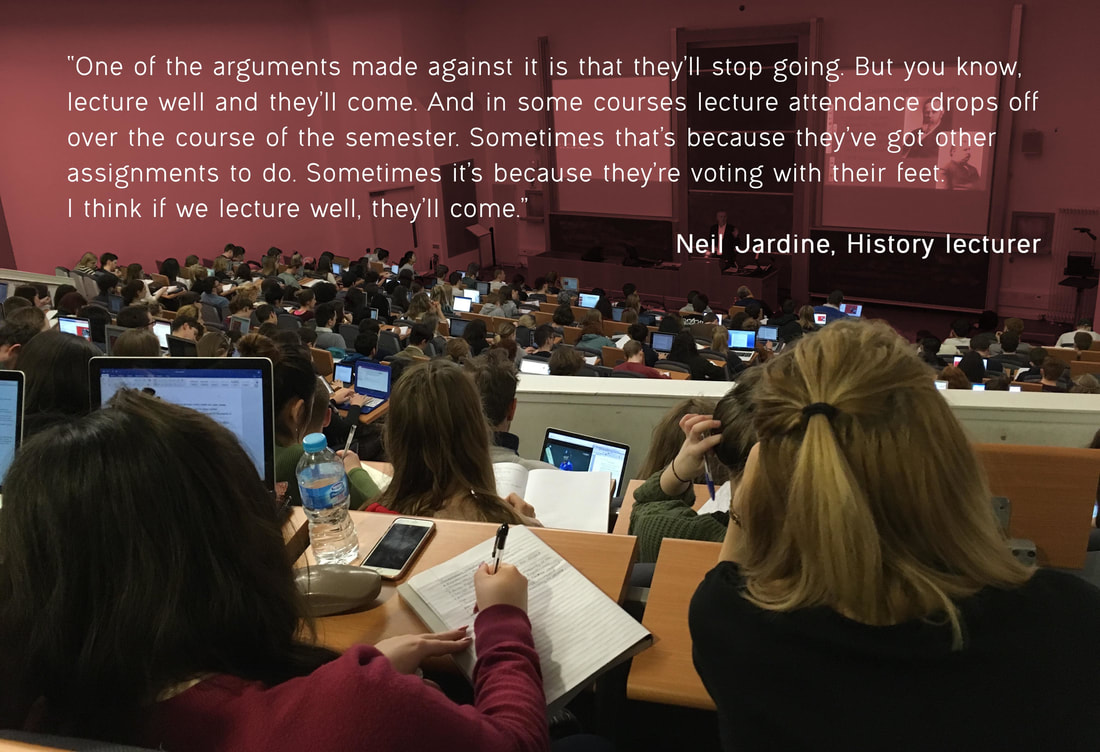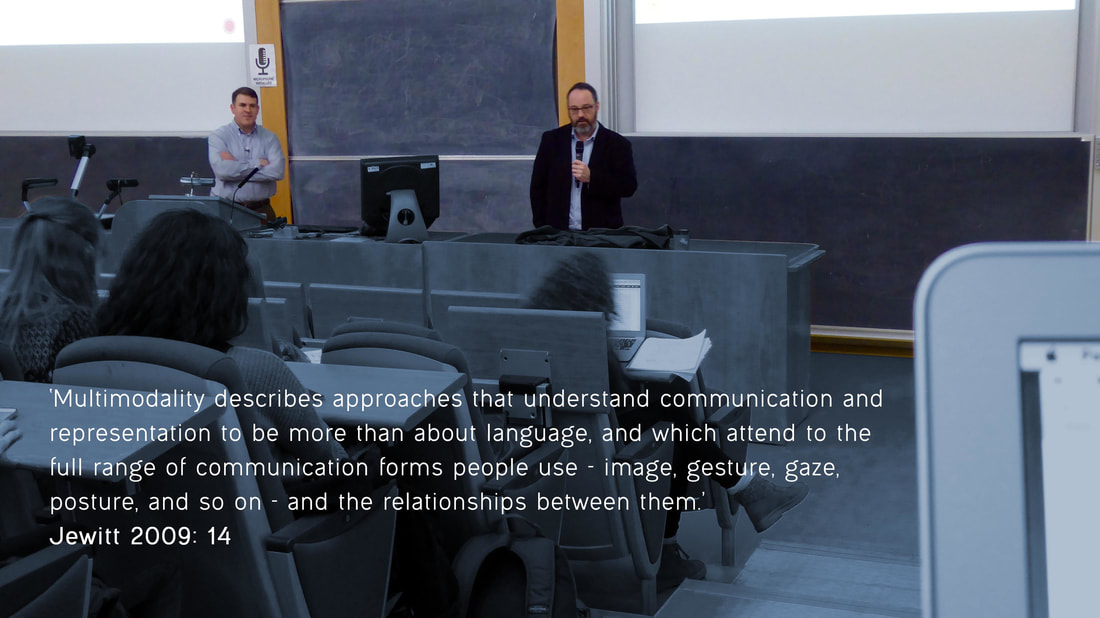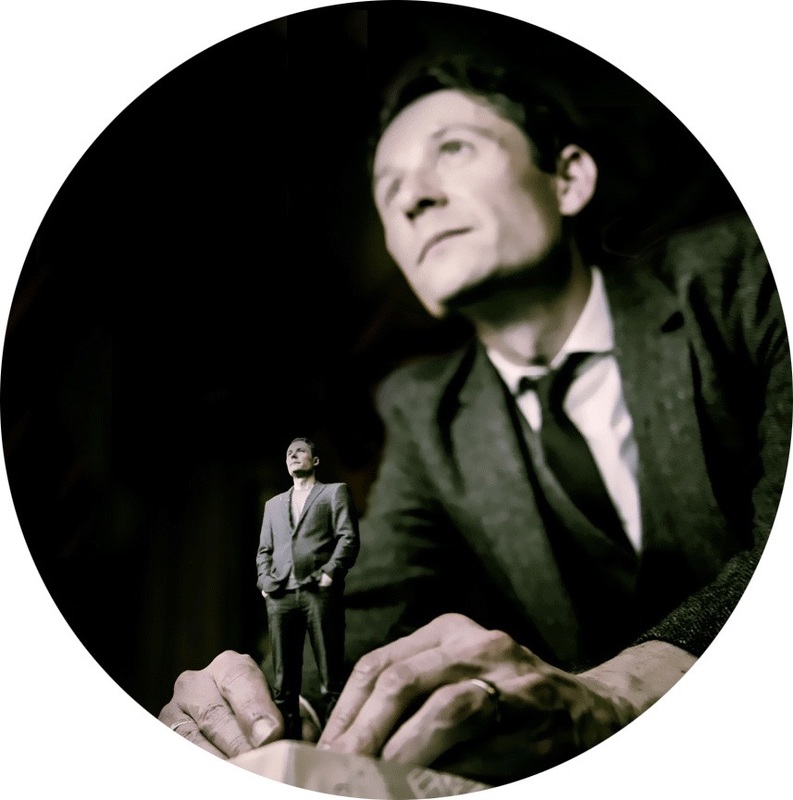|
Over the past three months I have been interviewing students and tutors from an undergraduate History course as I have sought to understand how meaning-making around assessment is affected by the pedagogic and societal shift to the digital. One of the subjects that we discussed - often introduced as a topic of conversation by interview participants themselves - concerned the forthcoming roll-out of lecture recording technology here at Edinburgh University. With the consent of interview participants (comprising five students and five tutors, represented here using pseudonyms) I have reproduced and reflected upon some of the insights they shared. I make no claim to generalisability and what follows reflects the broader interest of my Doctoral research, pointing towards our complex relationship with digital resources. To begin, the interviewed students broadly saw lecture recording technology as a positive development, predominantly as a resource to return to after class. Suggested benefits included the possibility of revisiting complex ideas that had been covered during the lecture, or particular points where it hadn’t been possible to capture the detail put across by a lecturer. The availability of lectures on video was seen by one student as a "safety blanket" with others welcoming the way it would compensate for the occasions across the semester where illness prevented them from attending class. Several students pointed towards the value of lecture recording as a revision tool, enabling them to look back over lecture content some time after the classes had taken place. Meanwhile two of the students I spoke to also felt it would enhance the lecture experience itself as they would be able to spend more time thinking about what the lecturer was saying, rather than attempting to take notes. For their part tutors were overall less certain of the benefits that lecture recording would bring, whilst simultaneously recognising its inevitably. Questions were raised around whether it represented the best use of resources, how it might affect the natural rhythm of a course and most commonly, whether it would really support exam revision in some of the same ways that students had suggested:
Rather than positively contributing towards exam revision, some tutors instead suggested that any benefit was more likely to come from the (continued) support of students with learning adjustments, as well as those members of the class who had a first language other than English. Students who missed or misheard part of the tutor's oral delivery would have the benefit or re-watching the corresponding part of the lecture after class, it was suggested. While all five students that I spoke to broadly welcomed the roll-out of lecture-recording, this was accompanied by a sense of unease around some of its potential effects. A common thread across the interviews was that the convenience of watching video recordings of lectures would make the prospect of attending class less attractive. Lectures most at risk of dwindling attendance would be those taking place at the beginning of the day, those within courses that didn’t use exam assessment and, more bluntly, where the subject matter or its delivery was less than inspiring. For the most part these observations were made in relation to other students, rather than interviewees themselves. In fact, in contradiction to the current tendency to suggest that the conventional lecture has run its course, the students I spoke to were overwhelmingly positive about the lecture as a teaching method, pointing for instance to the enjoyment of watching highly skilled teachers, the structure that it lent to their pattern of study and, from a mental health perspective, as a way of getting them out of the house. Even if lecture attendance might lose out to the occasional lie-in, it remained a vital part of the university experience:
Adopting a position similar to that of their undergraduates, several of the tutors I interviewed felt that as long as the subject matter was interesting and delivered in an interesting way, most students would still prefer to attend lectures. At the same time there was an acknowledgement that attendance already tends to decline across the semester - and that some courses already give clear evidence of students "voting with their feet", as one tutor described it. What didn’t arise in conversation, but would be fascinating to observe next semester, is whether students with previously poor attendance might access more lecture content through the convenience of it being available online? Meanwhile, a further insight which would seem to reflect the neo-liberalisation of higher education, came from a student who suggested that as long as he was paying thousands of pounds in course fees he, rather than the university, had the right to decide whether it was preferable to attend lectures or to watch their recorded equivalent. Amongst the tutors more concerned about declining attendance there was a question over whether a video recording of a lecture represented a diluted version of what takes place in class. Reminding us that an effective lecture is more than the oral dissemination of content, one tutor pointed to the way that eye contact, conversation and physical movement towards the audience were aspects of the learning experience that would be lost on those viewing a video recording of the lecture. Furthermore, drawing on the experience of teaching on a MOOC, a tutor described the problem of teaching in the absence of the visual cues and other subtle forms of feedback that enhanced his delivery. Thinking about conceptual work around multimodality where it is argued that every communicational act depends on a range of different semiotic content (Jewitt 2009, Kress 2010), it is interesting to consider how the particular configuration of resources within the classroom lecture compares with a video-mediated equivalent (and how in turn this impacts upon knowledge-construction). For instance, how would the absence of eye contact and physical proximity to the lecturer affect interpretations of meaning around a video recording of a lecture?
Looking beyond the practice of delivery the lecture, all of the tutors I spoke to suggested that the content of their slides would need to adapt to recognise that they more explicitly had a life beyond the classroom. This wasn’t necessarily seen as a negative consequence of lecture recording: on the contrary a number of tutors admitted that in future they would pay closer attention to issues of copyright around the use of images. Potentially more problematic according to one tutor was the way that a video seen outside the setting of the lecture class might not convey nuance, potentially leading to misunderstandings and other consequences. The consensus across tutors however was that their approach to delivering lectures would not change in any great way. Several tutors pointed to the historical longevity of the lecture and its efficiency as a medium for reaching large numbers of students in a way that seemed to be positively received (a view supported by the students I spoke to). The overall sense I got from tutors was that, irrespective of the proposed benefits or possible problems attached to the roll-out of lecture recording, it wouldn’t dramatically affect their approach or indeed what takes place in the classroom.
If the classroom experience might largely remain the same, it is interesting to further consider how the experience of viewing a lecture recording might differ from being present in the classroom. It is instructive for instance to look at work by Dicks et al (2006) where they investigated the relative abilities of digital media to record events. While video is able to record moving image and sound, Dicks et al. helpfully remind us that it still offers a selective visual representation of the lecture, dependent upon the positioning and gaze of the camera. Without suggesting this would necessarily be a drawback, the experience of watching a video recording would exclude a panoramic sense of what is taking place in the lecture. Still with an interest in the character of digital recording technologies, it is also worth considering how the experience of viewing the video recording would be subject to the particular capabilities of the computer, tablet or smartphone that it is viewed upon. The visual culture scholar Nicholas Mirzoeff (2015) is amongst those who have drawn attention to the way that sophisticated sensors and code manipulate and reconstruct a digital representation of what is seen or heard. The question arises therefore as to how the exposition of meaning conveyed within a lecture is affected by the complex and concealed calculations that contribute to the way images and sounds are recorded and reproduced for later consumption in digital video form. Finally, without suggesting that the lecture setting is free from distraction (not least by the temptations of Facebook and internet shopping, as I have witnessed whilst observing the History course across two semesters), a number of the students I spoke to suggested that the classroom environment better enabled them to remain focused on the task in hand, compared to competing interests on or beyond the screen.
Thinking meanwhile about embodiment and sensory meaning-making (see for instance Pink 2009), the tactile, physical and corporeal experience of the lecture environment would inevitably be different from the cafe, student flat, library or wherever else a student might watch the video recording. If we accept that light, heat, temperature and touch contribute towards our disposition and therefore our learning, it is interesting to consider how meaning-making within an environment that is purpose-built for teaching might be different to watching a video recording in ostensibly social spaces.
As I wrote within the introduction to this post, my interest lies in the way that meaning-making is affected by the increasingly digital nature of higher education and society more generally. Lecture recording, as I have attempted to show here, is a single example of the complex relationship between student, tutor, subject and technology. In this instance I think it has also shown how vital and inspiring some of long-standing teaching traditions can be. While there was uncertainty expressed surrounding the impact of lecture recording technology, there will evidently continue to be a place for the skilled lecturer enthusiastically sharing his or her work with an interested and inquisitive audience. References
See also: How do students differently approach assessment? The visual, multimodal History classroom
4 Comments
Hi James
Reply
James
25/7/2017 14:07:07
Thanks for your reply, Anna.
Reply
Kay Williams
18/10/2017 16:15:54
On the relationship between attendance and using lecture recordings it is worth taking a look at the paper below by Yeung et al (2016). Students seemed to find the face-to-face lectures and videos complemented each other. However, although students said they wanted the recordings the actual use of them suggested they didn't always make the time to do so.
Reply
James
9/9/2018 14:59:57
Thanks for this, Kay. I'm coming back to this topic now after a break and am going to follow up the reference. Much appreciated!
Reply
Leave a Reply. |
Search categories
All
I am a Lecturer in Digital Education (Education Futures), within the Centre for Research in Digital Education at The University of Edinburgh.
@james858499 [email protected] |



